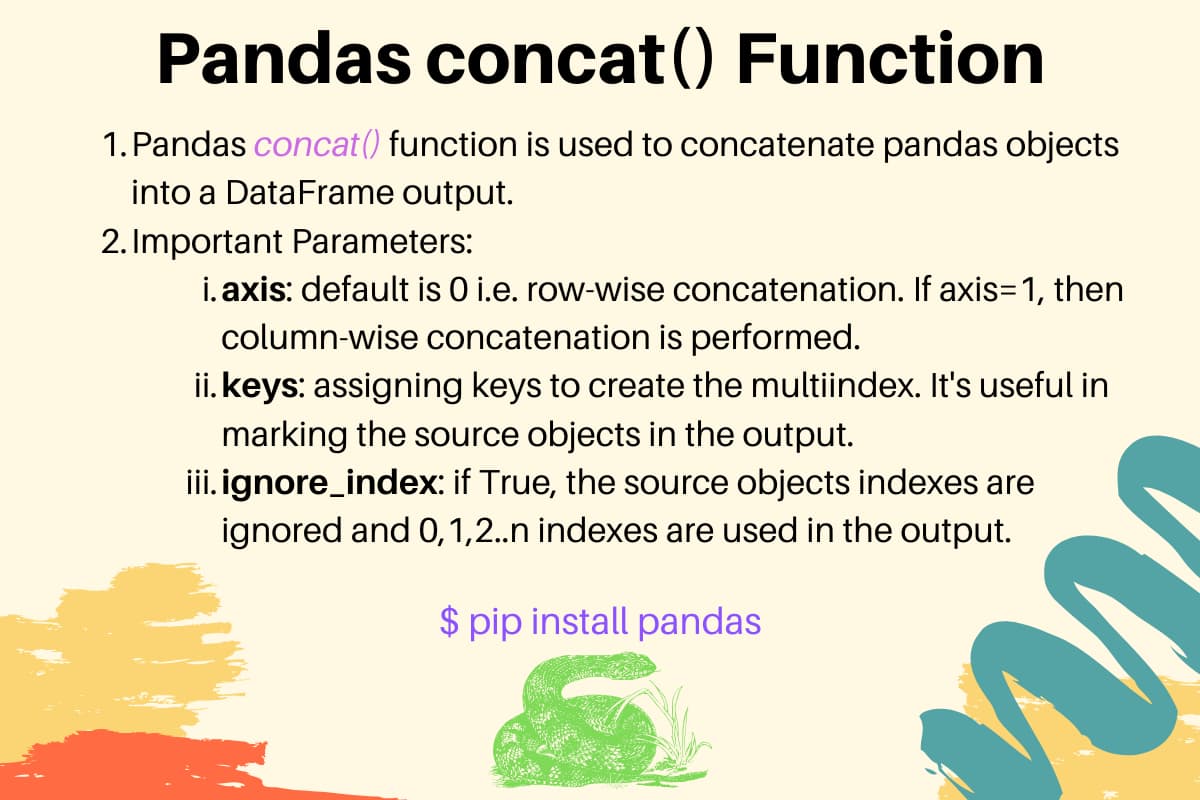- Log in to:
- Community
- DigitalOcean
- Sign up for:
- Community
- DigitalOcean

Pandas concat() method is used to concatenate pandas objects such as DataFrames and Series. We can pass various parameters to change the behavior of the concatenation operation.
1. Pandas concat() Syntax
The concat() method syntax is:
concat(objs, axis=0, join='outer', join_axes=None, ignore_index=False,
keys=None, levels=None, names=None, verify_integrity=False,
sort=None, copy=True)
- objs: a sequence of pandas objects to concatenate.
- join: optional parameter to define how to handle the indexes on the other axis. The valid values are ‘inner’ and ‘outer’.
- join_axes: deprecated in version 0.25.0.
- ignore_index: if True, the indexes from the source objects will be ignored and a sequence of indexes from 0,1,2…n will be assigned to the result.
- keys: a sequence to add an identifier to the result indexes. It’s helpful in marking the source objects in the output.
- levels: a sequence to specify the unique levels to create multiindex.
- names: names for the levels in the resulting hierarchical index.
- verify_integrity: Check whether the new concatenated axis contains duplicates. It’s an expensive operation.
- sort: Sort non-concatenation axis if it is not already aligned when join is ‘outer’. Added in version 0.23.0
- copy: if False, don’t copy data unnecessarily.
Recommended Reading: Python Pandas Tutorial
2. Pandas concat() Example
Let’s look at a simple example to concatenate two DataFrame objects.
import pandas
d1 = {"Name": ["Pankaj", "Lisa"], "ID": [1, 2]}
d2 = {"Name": "David", "ID": 3}
df1 = pandas.DataFrame(d1, index={1, 2})
df2 = pandas.DataFrame(d2, index={3})
print('********\n', df1)
print('********\n', df2)
df3 = pandas.concat([df1, df2])
print('********\n', df3)
Output:
********
Name ID
1 Pankaj 1
2 Lisa 2
********
Name ID
3 David 3
********
Name ID
1 Pankaj 1
2 Lisa 2
3 David 3
Notice that the concatenation is performed row-wise i.e. 0-axis. Also, the indexes from the source DataFrame objects are preserved in the output.
3. Concatenating Along Column i.e. 1-axis
d1 = {"Name": ["Pankaj", "Lisa"], "ID": [1, 2]}
d2 = {"Role": ["Admin", "Editor"]}
df1 = pandas.DataFrame(d1, index={1, 2})
df2 = pandas.DataFrame(d2, index={1, 2})
df3 = pandas.concat([df1, df2], axis=1)
print('********\n', df3)
Output:
********
Name ID Role
1 Pankaj 1 Admin
2 Lisa 2 Editor
The concatenation along column makes sense when the source objects contain different kinds of data of an object.
4. Assigning Keys to the Concatenated DataFrame Indexes
d1 = {"Name": ["Pankaj", "Lisa"], "ID": [1, 2]}
d2 = {"Name": "David", "ID": 3}
df1 = pandas.DataFrame(d1, index={1, 2})
df2 = pandas.DataFrame(d2, index={3})
df3 = pandas.concat([df1, df2], keys=["DF1", "DF2"])
print('********\n', df3)
Output:
********
Name ID
DF1 1 Pankaj 1
2 Lisa 2
DF2 3 David 3
5. Ignore Source DataFrame Objects in Concatenation
d1 = {"Name": ["Pankaj", "Lisa"], "ID": [1, 2]}
d2 = {"Name": "David", "ID": 3}
df1 = pandas.DataFrame(d1, index={10, 20})
df2 = pandas.DataFrame(d2, index={30})
df3 = pandas.concat([df1, df2], ignore_index=True)
print('********\n', df3)
Output:
********
Name ID
0 Pankaj 1
1 Lisa 2
2 David 3
This is useful when the indexes in the source objects don’t make much sense. So we can ignore them and assign the default indexes to the output DataFrame.
Thanks for learning with the DigitalOcean Community. Check out our offerings for compute, storage, networking, and managed databases.
About the author
Java and Python Developer for 20+ years, Open Source Enthusiast, Founder of https://www.askpython.com/, https://www.linuxfordevices.com/, and JournalDev.com (acquired by DigitalOcean). Passionate about writing technical articles and sharing knowledge with others. Love Java, Python, Unix and related technologies. Follow my X @PankajWebDev
Still looking for an answer?
Hi ! i want to use concatenate function for each row of 2 or most column of my dataset in pandas. Ex: i have a series with 3 columns (NAme, Age , country ) of 10 rows (person). So I want to create a new column which concatenate for each person his name, age and country like (David22USA) Thank for your help.
- Soufiane CAMARA
Hi Pankaj, thanks for the work. One bit I don’t get. In 4. Assigning Keys to the Concatenated DataFrame Indexes, the index on the far left column shows DF1, then blank, then DF2. ******** Name ID DF1 1 Pankaj 1 2 Lisa 2 DF2 3 David 3 I don’t get the value of leaving the second row blank. How would i search on that? If i ran a query to gather all rows from the d1 data using the far left index col as a the column to search in, it would miss the second row. I don’t understand why anyone would do this. Thanks.
- Stu David
- Table of contents
- 1\. Pandas concat() Syntax
- 2\. Pandas concat() Example
- 3\. Concatenating Along Column i.e. 1-axis
- 4\. Assigning Keys to the Concatenated DataFrame Indexes
- 5\. Ignore Source DataFrame Objects in Concatenation
- 6\. References
Deploy on DigitalOcean
Click below to sign up for DigitalOcean's virtual machines, Databases, and AIML products.
Become a contributor for community
Get paid to write technical tutorials and select a tech-focused charity to receive a matching donation.
DigitalOcean Documentation
Full documentation for every DigitalOcean product.
Resources for startups and SMBs
The Wave has everything you need to know about building a business, from raising funding to marketing your product.
Get our newsletter
Stay up to date by signing up for DigitalOcean’s Infrastructure as a Newsletter.
New accounts only. By submitting your email you agree to our Privacy Policy
The developer cloud
Scale up as you grow — whether you're running one virtual machine or ten thousand.
Get started for free
Sign up and get $200 in credit for your first 60 days with DigitalOcean.*
*This promotional offer applies to new accounts only.
